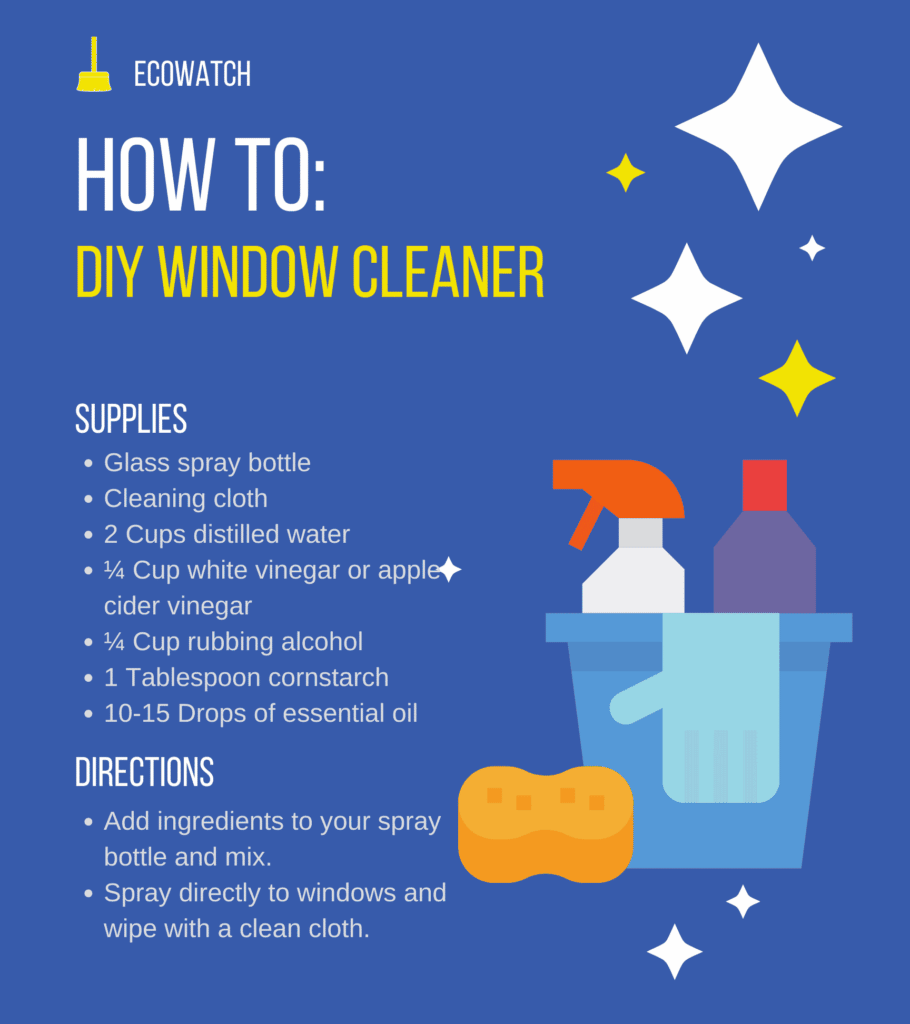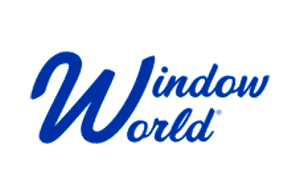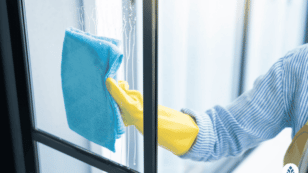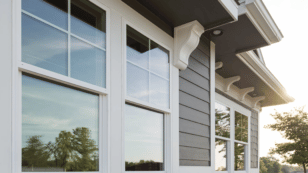
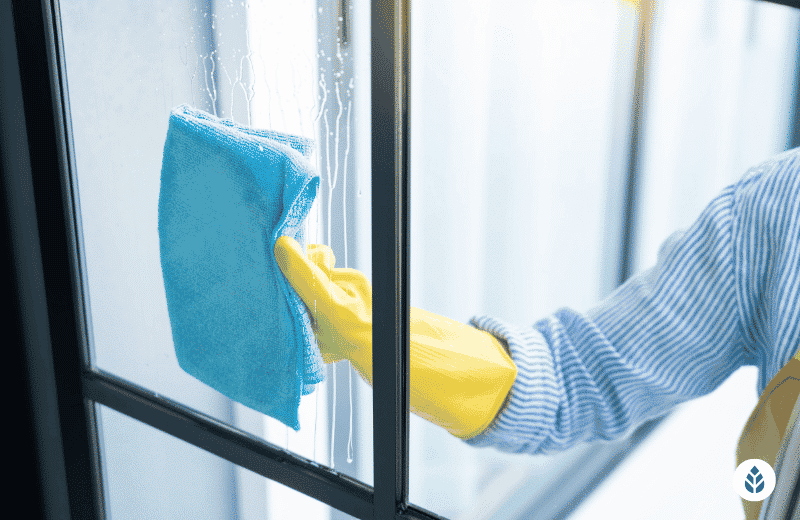
Eco-Friendly Window Cleaning: Recipes & Tips (2024 Guide)
In this DIY guide, we will discuss:
- How to make homemade window cleaner using simple ingredients
- What you need to achieve streak-free windows without harsh chemicals
- How to choose eco-friendly materials and avoid plastic pollution
Each product and or company featured here has been independently selected by the writer. You can learn more about our review methodology here. If you make a purchase using the links included, we may earn commission.
Imagine this: it’s a picturesque winter day. Your fireplace is crackling and you’re all bundled up on the couch with a steaming mug of hot cocoa. You look outside to admire the snow flurries falling down gently and — wait. What’s that on the window? It’s covered in dirt and grime.
Dramatics aside, keeping your windows clean is an important part of maintaining your home year-round. You should be able to look out and enjoy the natural beauty of the outdoors — unobscured by a film of dirt, debris or dust on the glass.
Unfortunately, when it comes time to clean your windows, too many glass cleaners on the market contain harmful chemicals that aren’t good for you, your pets or the environment.
Here’s how you can clean your windows safely and effectively and give those unhealthy ingredients the boot.

Renewal by Andersen

Save $375 Off Each Window
Average cost
Pros
- Great industry reputation
- Award-winning company
- Member of US Green Building Council
- Manufactures products in-house
Cons
- No lifetime warranty
- More expensive than competition
The Dos of Eco-Friendly Window Cleaning
It is possible to have sparkling clean glass in your home without harmful chemicals! We recommend either making your own window cleaner or choosing an eco-friendly brand. And don’t forget to use a cloth rather than paper towels!
- Make Your Own Window Cleaner
- Choose an Eco-Friendly Window Cleaner Brand
- Use a Squeegee or Cotton Cloth
Make Your Own Window Cleaner
The simplest way to make your own glass cleaner is to mix one part vinegar and one part water in a spray bottle. If you’d like, you can add a few drops of essential oil to improve the smell. Or, If you have orange, lemon or grapefruit peels lying around, try steeping them in the window cleaning mixture for a few days.
Once you take them out of the cleaning solution, you can even grind them up in your garbage disposal to naturally clean it and improve the smell of your sink.
However, with a few more very simple ingredients, you can elevate your homemade solution to something stronger.
Supplies
- Glass spray bottle (do not reuse an old household cleaner bottle)
- Cleaning cloth
Ingredients
- 2 cups water (distilled water is best)
- 1/4 cup white vinegar or apple cider vinegar
- 1/4 cup rubbing alcohol (isopropyl alcohol)
- 1 tablespoon cornstarch
- 10-15 drops of essential oil (optional)
Total Time Required
- Five minutes
Directions
Add ingredients to your spray bottle and mix. Spray directly to windows and wipe with a clean cloth.
What the ingredients do:
- Vinegar has acetic acid, which kills some bacteria and helps break down dirt and grease
- Cornstarch acts as a mild abrasive to lift residue
- Rubbing alcohol helps kill germs and works with the vinegar to remove smudges
- Essential oil provides a pleasant smell, and some essential oils have antimicrobial properties
Or, Choose An Eco-Friendly Window Cleaner Brand
We understand that making your own homemade cleaning products isn’t for everyone. Thanks to the growing demand for sustainable and environmentally friendly home products, there are now plenty of eco-friendly window cleaner brands on the market.
If you want to see for yourself if your favorite product is safe for you and the planet, look to see if a product is part of the Environmental Protection Agency’s (EPA) Safer Choice Program. The EPA verifies products actually striving to be healthier for humans and the environment.2
One eco-friendly product that’s verified by the EPA’s Safer Choice Program is ECOS Window Cleaner.
Another popular multi-use product is Dr. Bronner’s liquid soap. Dr. Bronner’s soaps can be found at most retailers and have no preservatives, detergents or foaming agents. They can be diluted and used as a window cleaner or multipurpose cleaner.
Avoid products with detergents, disinfectants or grease-cutting agents. The Cleveland Clinic recommends avoiding the following ingredients:
- Ammonia
- Ethylene glycol monobutyl acetate
- Trisodium phosphate
- Sodium hypochlorite3
Use a Squeegee or Cotton Cloth
When choosing what tool to wipe your window with, a squeegee is a great option for avoiding streaks. Squeegees also last for years and don’t leave behind bits like disposable paper towels.
If you’d rather go with a cloth, go with a cotton rag that can be reused hundreds of times. Natural fibers like cotton are best because they won’t release microplastics into waterways when they go through the wash.
All in all, the best tool for cleaning windows is the one you already have. Old rags, scraps of fabric or even newspaper can be used to wipe your windows clean.
The Don’ts of Eco-Friendly Window Cleaning
Now for what not to do when you’re cleaning your windows: avoid harmful products and don’t use paper towels or new microfiber rags.
- Don’t Use Paper Towels
- Don’t Buy New Microfiber Rags
- Don’t Forget to Look at Your Cleaner’s Ingredients
Don’t Use Paper Towels
Paper towels aren’t very environmentally friendly, plus they leave behind annoying fibers on your windows. Paper towels are convenient, but not without a price. Consider this: 270 million trees are cut down each year to produce paper towels. At the end of their (very short) life, almost all of them end up in landfills, where they release methane during decomposition.
On top of that, paper towels can’t be recycled due to contamination from food or other substances and are usually packaged in non-recyclable plastic wrap.4
Don’t Buy New Microfiber Rags
You’ve decided you don’t want to spend your hard-earned coin on paper towels you’ll just throw away anyway. Now what?
You may be tempted to head out to the store and pick up a brand new pack of microfiber cloths, but think twice before you buy. Although microfiber cloths can achieve a streak-free shine on your windows, they are made of synthetic threads that release tiny microfibers when washed. Microfiber cloths are typically made of a polyester-nylon blend, which is a petroleum-based, non-biodegradable material.5 To reduce the microplastic pollution you’re creating when you wash synthetic fabrics, wash larger loads in cooler, shorter cycles.6
Overall, microfiber cloths are still more eco-friendly than disposable paper towels that emit carbon dioxide during production, cannot be recycled and release methane in landfills. That being said, if you absolutely have to go out and buy something new, stick with a squeegee or cotton cloth. Better yet, if you have some old clothes lying around, cut them up to use as a rag.
Don’t Forget to Look at Your Cleaner’s Ingredients
If you go with a store-bought window cleaner, take a look at the cleaner’s ingredients before you buy. Products containing ammonia and bleach are harsh and rarely necessary to achieve a clean home, and vague claims on a label that a product is “green” rarely mean anything.
Instead, look for products with specific, substantiated eco-friendly practices detailed on the label.
The Benefits of Eco-Friendly Cleaners for Windows
By using natural ingredients when possible, you are reducing the irritants and harsh cleaning chemicals you’re being exposed to in your home. When you make your own cleaning solutions, you can reuse and refill the bottles as many times as you want, reducing plastic waste and helping you control exactly how much of a substance you are using. According to the American Lung Association, traditional cleaning supplies can cause eye and throat irritation, headaches, allergic reactions and even cancer.7
Homemade window cleaner can be used on many surfaces, including car windows, shower doors and most countertops. If you’re looking to expand your repertoire of natural, all-purpose cleaners, baking soda and apple cider vinegar are two versatile, nontoxic cleaning agents that you can incorporate into your routine.
Other Ways to Have Environmentally Friendly Windows
It may not be something you think about often, but windows can drastically affect the energy efficiency of your home. Consider the following ways that you can make your windows more environmentally friendly:
Invest in Energy-Efficient Windows
If your windows are old or damaged, you’re probably wasting a lot of energy through the cracks. Buying energy-efficient windows can be a great investment for your home, so consider checking out the best window replacement companies.
Weatherize Your Windows
If you aren’t ready to replace your windows entirely, you can still prevent that precious air conditioning or heat from escaping through your windows. Check each of your windows to make sure the seal is tight. If not, try weatherizing the windows by weatherstripping, using a window treatment or applying a window insulation kit.
Choose Windows That Face the Right Direction
Okay, you can’t change the orientation of the windows already installed in your home, but if you’re building a home or looking to buy a new one, you may want to think about what direction your windows are facing.
The best direction for windows to face depends on your location and the time of year. South-facing windows are best for heating performance, meaning that let in more sunlight and warmth. North-facing windows filter in the least amount of light, meaning that they’re best for keeping your home cool.8,9
Additional Window Cleaning Tips
To get the cleanest possible windows and get the most out of your cleaning solution, refer to the following handy tips:
- Clean your windows twice a year to prevent mineral deposit buildup
- Work top to bottom when cleaning windows to avoid drips and streaks
- Wait a few minutes after spraying your surface to wipe it down to maximize effectiveness
- Dust window screens with a lint roller
- Remove hard water spots on your glass surfaces by spraying a mixture of one part white vinegar and one part water onto the affected area and letting it sit for 10 minutes before wiping it off
- Use hot water in your solution for maximum effectiveness
FAQ: Homemade Window Cleaner
You can achieve streak-free windows using a homemade window cleaner and a clean cloth. A simple homemade cleaning solution is one part water and one part white vinegar mixed in a spray bottle.
The best homemade window cleaner has water, white vinegar, rubbing alcohol and cornstarch. Mix the ingredients in a spray bottle and wipe using a squeegee or clean cloth.
Yes! Homemade window cleaners can effectively clean your windows without harsh chemicals, irritants, fragrances or dyes.

 233k
233k  41k
41k  Subscribe
Subscribe 
